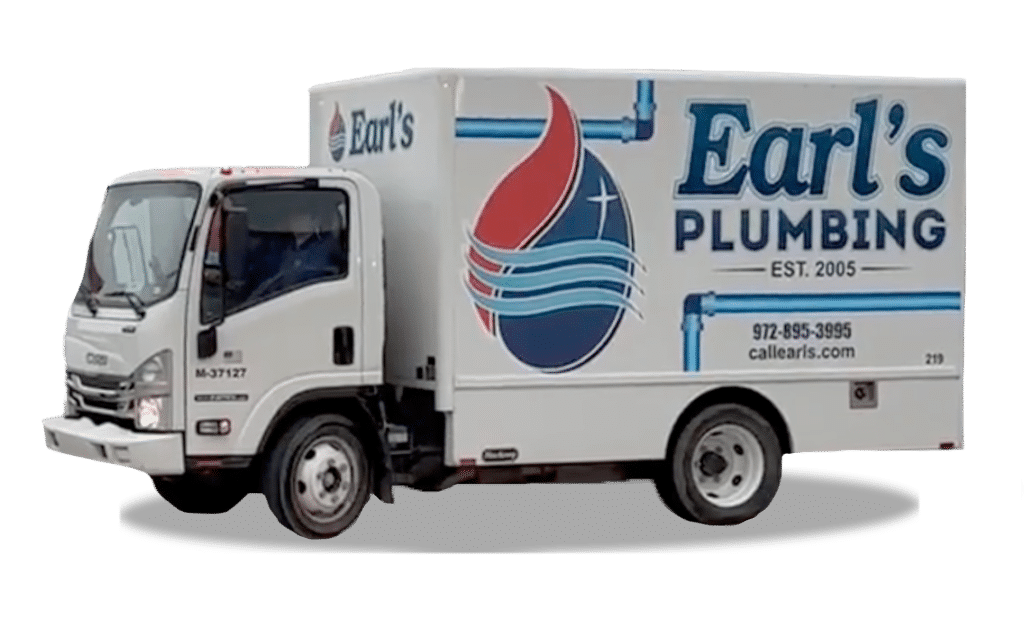Frisco’s Trusted Plumbers for Hose Spigot & Yard Hydrant Replacement
One of the most common repair calls that we get is for hose spigots—that fixture on the outside of your house that you connect your water hose to. When the winter ends and you start bringing out the patio furniture, the gardening tools, and the inflatable pools, it’s common to find a leak or rupture in your hose spigot. Whether due to age or freezing, a spigot problem can lead to much more expensive repairs down the line if you don’t address it quickly.
At Earl’s Plumbing, we have extensive experience replacing worn-out and ruptured hose spigots and yard hydrants throughout Frisco, McKinney, Plano, and beyond. Whether it’s a simple, straightforward replacement or a more complex plumbing project, we’re always prepared to handle whatever comes our way. We’ll always recommend the course of action that will save you the most time and money in the long run so you can focus on enjoying your backyard oasis.
What Do You Call the Thing You Connect Your Hose To?
Hose spigot design is fairly simple, functioning like a multi-turn gate valve. But spigots have two major differences from your standard gate valve. The first is a safety feature to prevent the backflow of contaminants and the other is a frost-proof feature. Depending on where you were raised, you might call it:
These various terms all refer to the same fixture. Although they may look slightly different, they all serve the same function and purpose, and all operate in roughly the same manner. In the plumbing world, the technical term used most often is “hose spigot” followed closely by “hose bibb.”

Request a Plumbing Estimate Today
"*" indicates required fields
Answers to Your Frequently Asked Questions
At Earl’s Plumbing, we’re happy to provide you with the top tips for prolonging the life of your hose spigot or yard hydrant and when it’s time to replace. Get comprehensive answers to your questions below.
- Backflow Prevention Device: By plumbing code, each hose spigot must be equipped with a backflow prevention device. This device is also called a vacuum breaker. When operating correctly, this serves as a safety feature that prevents hose water from backing up into the main potable (drinkable) water supply. This is just in case contaminants such as yard waste or chemicals got into the hose. A backflow prevention device stops those contaminants from entering the drinkable water supply, much like the double check valve (DCV) does for irrigation water. The vacuum breaker is designed to briefly allow a little water to leak out when the hose spigot is turned ON and/or OFF. That brief leakage is not a hose spigot problem—it’s by design. That said, the water flow is NOT supposed to be continuous or present when the garden hose or spigot is in use and under pressure. If you have any water coming from the hose spigot during use, then it is starting to develop a leak and/or fail.
- Freeze-Proof Design: The freeze-proof feature of a hose spigot is that it is designed to self-drain after use. To do this, it must be installed at a slight angle that creates fall. In addition, it cannot self-drain when there is a water hose connected to it. Unfortunately, many homeowners regularly leave their water hoses attached well into January and throughout the winter. The self-draining feature will also NOT work if there is a leak or drip of any kind. That drip freezes and starts to create a small ice dam. Water continues to back up and continues to freeze more—then you get a pipe rupture. The hose spigot must be completely free of drips or leaks to function properly.
- Hose Spigot Leaks: Most leaks occur due to age. Because a hose spigot is a gate valve that has a limited life, it is designed to be replaced. We typically see most hose spigots lasting problem-free for about 5-7 years, but that’s not a hard fast rule. We have seen them last for much longer than that and also much less. But if you have water coming out of any part of the hose spigot fixture other than where it is supposed to, then it might be time to call Earl’s Plumbing. Keep in mind that a slow, uncontrolled drip can lead to a complete rupture if not fixed.
- Hose Spigot Ruptures: Ruptures are freeze-related damage. They are caused by water that can’t fully drain or an accumulation of a leak inside the hose spigot that freezes. The freezing water expands inside the copper pipe portion of the hose spigot and creates a split in the pipe. This type of damage usually cannot be identified until you turn the spigot on. Sometimes, the break is not severe enough until a hose is attached, creating back pressure.
If you see water coming from out of the brick, where the brick and concrete slab meet, or from the weep holes, you have a problem that needs to be addressed. If caught early enough, the water will not migrate inside the home where it can cause interior damage. But that all depends on how quickly the rupture is identified.
The reason for this decision is that the repair option usually takes longer to diagnose and complete than it does to replace the entire hose spigot. In addition, the first repair does not always fix the entire issue. Even if it does, the work often creates enough new pressure that another area will begin to leak. More often than not, the repair option fixes the problem temporarily, only for another leak to materialize.
In addition, many of the factory parts needed to make a proper repair are not available for purchase. To avoid this temptation, we do not even carry repair parts for hose spigots on our trucks.
In the end, there is far more value to the customer in replacing the entire hose spigot that will last multiple years versus a repair that may only last a few months to a year. Because we might replace multiple hose spigots in a day or even multiple spigots at one home, each of our trucks is supplied with multiple quantities of the various sizes required for almost any job.
Be aware that we must turn the water off to the entire house during a replacement. Hopefully, your main shut-off valve is easily located and functioning. Upon completion, you can expect there to be air in the lines, so don’t be alarmed. Because of the relatively inexpensive nature of the majority of these replacements, we do not have an additional cost built into the job to come inside and bleed all of the air out of every faucet.
Despite the fact that most replacements are straightforward, we always arrive expecting the unexpected. Our trucks carry all of the various sizes/lengths (five total plus various extensions and adapters) because we do not know what size will be needed until the old hose spigot is removed from the wall. The type of wall (siding, brick, stone, stucco, etc.) and the depth of the framed wall (2×4 or 2×6, etc.) all play a part in the length.
Although rare, a severely ruptured hose spigot can break off inside the wall. If this happens, the brick may need to be cut or the drywall opened up from the inside to gain access to the spot. For most plumbing companies, this would trigger an even larger expense and the need for a 3rd party to make the drywall or brick repairs. However, at Earl’s Plumbing, we have developed an effective system for handling this situation.
In the event that a spigot breaks off inside the wall, we can often still remove these broken-off pieces without the need to cut the drywall open or remove the brick. The success rate has been pretty high, and we have saved our customers thousands of dollars in additional repairs.
In older homes (built before 1990) or homes in the rural communities that we serve outside of Frisco, we do often find hose spigots where the entire line has been sweated or “hard piped.” That means it is not a basic replacement.
When we run across these, we will brainstorm the best possible solution to permanently repair and prevent further leaks. Sometimes, customers ask us to just cap the line, but that is the least likely solution that we would agree to do because it’s just not good or smart plumbing.
But if you are going to attempt to DIY this relatively inexpensive replacement, don’t waste your time or money buying a replacement hose spigot from one of the big box retail home improvement stores. They are either poor quality and/or do not meet the various city code requirements. Earl’s Plumbing will not use these cheap spigots and neither should you.
A yard hydrant connects to the water line below the ground. If properly installed, it should be packed in pea gravel to allow for self-draining and prevent freeze ruptures. To operate these unique shut-off valves, you usually lift or turn the handle up or down. This mechanically operates a metal rod that opens and/or closes a plunger-style device below the soil surface.
Yard hydrants can usually be found in barns, stables, greenhouses, and/or where a water line was run to an open area of land, such as a pasture, field, golf course, or garden. However, they’re also an option for a water hose connection should you have a salt tablet water softener system that was installed after construction.
You cannot water your grass, plants, shrubs, or container gardens with the water that comes from a salt tablet softener system because it is salt water. Unless your hose spigots were connected and/or bypassed from the system at the time of construction or during the softener installation phase (unlikely), then a yard hydrant teeing off of your main water line BEFORE the softener line may be your only option for a clean, fresh, salt-free water source where you need it.
But to avoid the major ruptures that can lead to property damage or more costly repairs, you MUST prepare for the freezing weather with a few simple steps:
- Remove or disconnect ALL water hoses, pool fill lines, soaker hoses, Y splitters, hose manifolds, and/or irrigation connections.
- Make sure that there are no existing leaks or drips of any kind, regardless of the rate. TIP: If small drips or leaks are present, there are some nutted areas that can be lightly snugged or tightened. If that does not stop the leak, call us for a replacement.
- Purchase and properly install a hose spigot cover, available at the local big box home store. The hard-shell foamed cones seem to be the best option.
- When using your hose spigot for the first time after a freeze, connect a hose and let it fill up. Then wait 20-30 seconds or so before walking away to ensure you do not have water coming out of the wall under the hose spigot and/or near the slab.
See What Frisco is Saying About Our Hose Spigot Replacement Services

